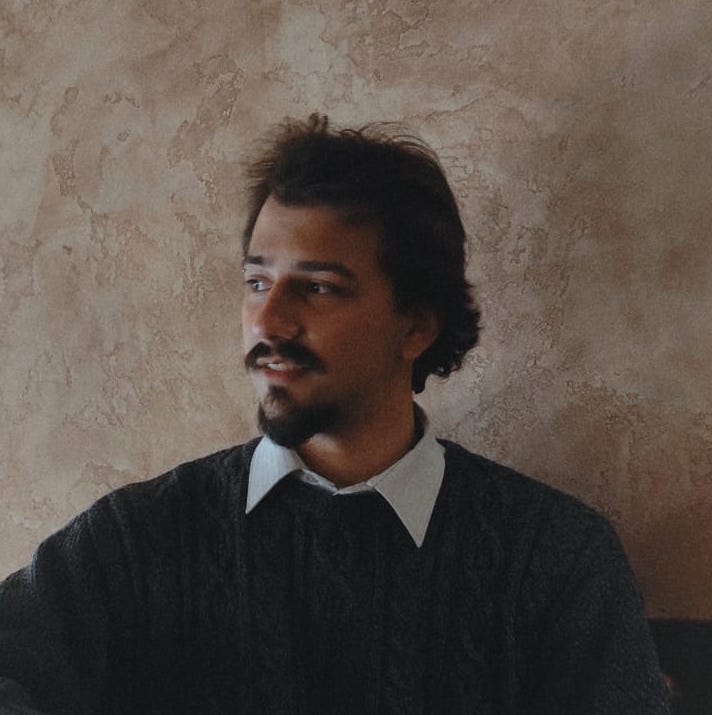You have a Mac computer and projects to manage? Well, you’ll be glad to know there are many apps on the market that can help macOS users organize tasks and collaborate with ease.
But it’s not just about compatibility. The right tool should offer a balanced mix of features, visual appeal, and affordability.
That’s why I tested and reviewed 10 PM platforms on my Mac, breaking down their strengths and weaknesses.
Let’s help you find the perfect tool to keep your projects running smoothly!

In this article:
Top 10 project management tools for Mac
| Tool | Best for | Free trial | Free plan | Starting price |
|---|---|---|---|---|
| Plaky | Mac users overall | ✔ | ✔ | $3.99/seat/month |
| Notion | Knowledge organization | ✔ | ✔ | $10/seat/month |
| Asana | Workflow automation | ✔ | ✔ | $10.99/user/month |
| Teamwork | Client-focused projects | ✔ | ✔ | $10.99/user/month |
| monday.com | Agile workflows | ✔ | ✔ | $9/seat/month |
| Smartsheet | Data-driven project management | ✔ | ❌ | $9/member/month |
| Wrike | Resource management | ✔ | ✔ | $10/user/month |
| Basecamp | Simplified team communication | ✔ | ✔ | $15/user/month |
| Todoist | Minimalists | ✔ | ✔ | $4/user/month |
| Miro | Brainstorming sessions | ✔ | ✔ | $8/member/month |
#1 Plaky — best for Mac users overall
Plaky is a project management tool that lets teams across various industries plan, organize, and execute projects. The focus is on simplicity and seamless collaboration, as well as offering a budget-friendly solution.
Pros of using Plaky as a PM tool for Mac
Plaky relies on a hierarchical structure with Spaces at the top level, followed by boards, and then individual items within those boards.
For example, a single Space can represent a department or team, boards individual projects, and items specific project tasks.
Zooming in even more, items are described through Plaky’s versatile custom fields. This means you can specify project/task details such as:
- Description,
- Deadline,
- Budget,
- Assignee,
- Checklist,
- Status, etc.
Thanks to this flexibility, you could also make boards for different objectives, product roadmaps, backlogs — you name it.
Create versatile boards to manage your work in Plaky

Moreover, as someone who’s part of a project team that uses Plaky daily, I can point out some additional handy features:
- 3 board view types — table, Kanban, and Gantt chart views to meet every user’s needs and preferences,
- Plaky’s template center — pre-built templates to save time and ensure consistency,
- Activity log — a chronological record of all changes on the platform to catch mistakes and boost accountability, and
- Real-time notifications — so that you never miss an update again.
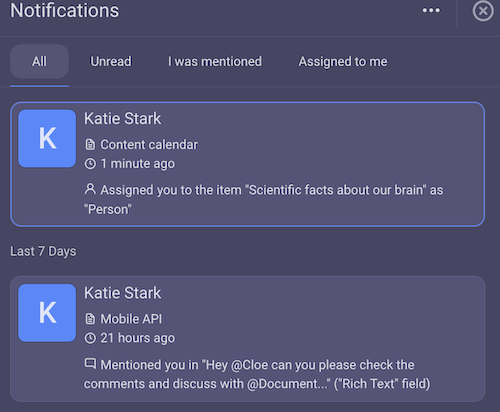
Now, Plaky doesn’t have a dedicated macOS app, but it’s fully accessible through any browser, so the web interface will work seamlessly on your Mac.
Plus, if you’re part of the Apple ecosystem through your smartphone as well, Plaky has an iOS app for project management on the go.
To top everything off, Plaky’s support team is available 24/7 — you can get help at any time, regardless of time zones.
Cons of using Plaky as a PM tool for Mac
At the moment, Plaky could grow its integration options to become even more practical for business purposes. However, you can install Plaky’s time-tracking integration with Clockify to gain more insights into your productivity.
What’s new in Plaky?
You can now get the so-called CAKE.com account — a single account with which you can use all CAKE.com tools (Plaky for project management + Clockify for time tracking and Pumble for team communication).
There have also been numerous minor fixes to make Plaky’s design and navigation even more polished.
Available for: web, iOS, Android
| Plaky’s plans | Plaky’s pricing |
|---|---|
| Free | $0 |
| Pro | $3.99/seat/month* |
| Enterprise | $8.99/seat/month* |
*billed annually

#2 Notion — best for knowledge organization
Notion is a productivity tool for task management, note-taking, and knowledge organization. Apart from being highly customizable and versatile, the platform also includes a range of features optimized for macOS.
Pros of using Notion as a PM tool for Mac
Everything on a Notion page is a block — text, tables, images, and more. You can combine these blocks however you like.
Mac users specifically can handle their task management in Notion smoothly through a dedicated desktop app. The key features are:
- Customizable workflows — timelines, Kanban, tables, calendars, etc. for visualizing tasks and milestones,
- Collaboration features — real-time editing, commenting, and @mentions for team communication, and
- Integration with Mac features — working seamlessly with macOS utilities like notifications and Apple Calendar sync.
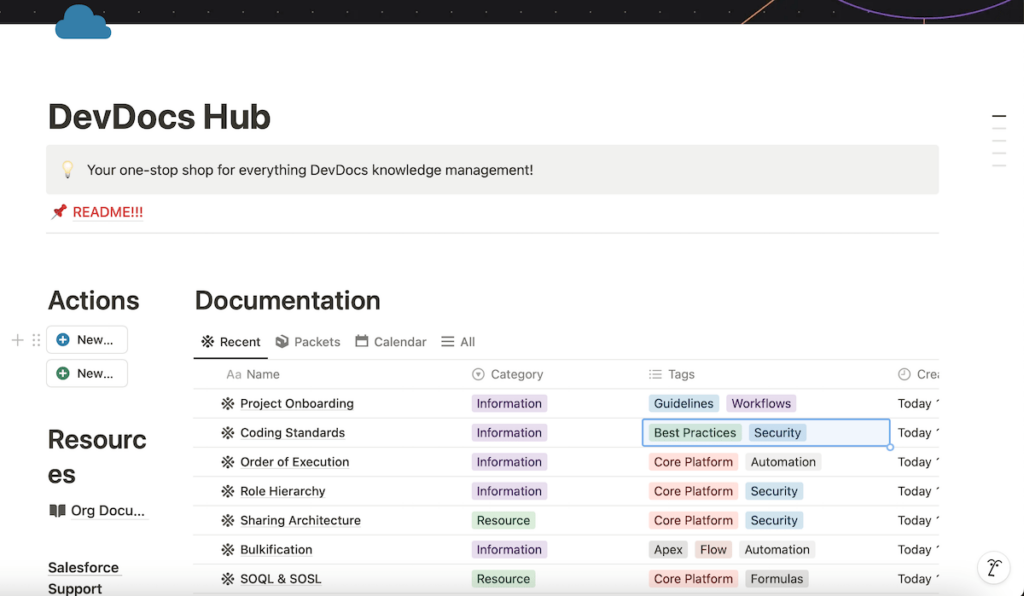
That said, I think Notion’s forte is that users can create a knowledge repository. For instance, I used Notion while researching a topic for an upcoming article, and these features proved to be quite practical:
- Rich content support — embedding multimedia, links, and documents to provide useful context,
- Hierarchical content organization — using pages and subpages for a clear organizational flow,
- Relational databases — linking pages and databases to make interconnected information ecosystems, and
- Drag-and-drop functionality — using the drag-and-drop block system to structure information quickly.
Cons of using Notion as a PM tool for Mac
While its adaptability can be useful, setting Notion up tends to be complex for beginners. In addition, large workspaces with extensive data could lead to slower load times, which is always frustrating.
I must also mention that the free plan is solid for individuals, but a team would most likely require one of the higher-tier plans — and those may feel expensive compared to some competitors.
What’s new in Notion?
Most recently, Notion updated its pricing and plan feature sets to include Notion AI only in Business and Enteprise plans. Other recent updates include a new database view (Feed view) and availability in 3 new languages: Indonesian, Thai, and Vietnamese.
Available for: web, macOS, Windows, iOS, Android
| Notion’s plans | Notion’s pricing |
|---|---|
| Free | $0 |
| Plus | $10/seat/month* |
| Business | $20/seat/month* |
| Enterprise | POA |
*billed annually
💡PLAKY PRO TIP
To learn how Notion compares to similar software, check out these articles:

#3 Asana — best for workflow automation
Asana is a PM platform whose aim is to help teams organize and track their work as effortlessly as possible. More specifically, Asana’s features and integrations are the most useful for teams looking to automate their processes.
Pros of using Asana as a PM tool for Mac
Asana is a solid option for project management because it supports:
- Task tracking — (sub)tasks with dates, assignees, priorities, etc.,
- Multiple views — list, board, timeline, and calendar formats,
- Project templates — ready-made templates to set up new projects faster, and
- Team collaboration — assigning tasks and commenting to stay aligned.
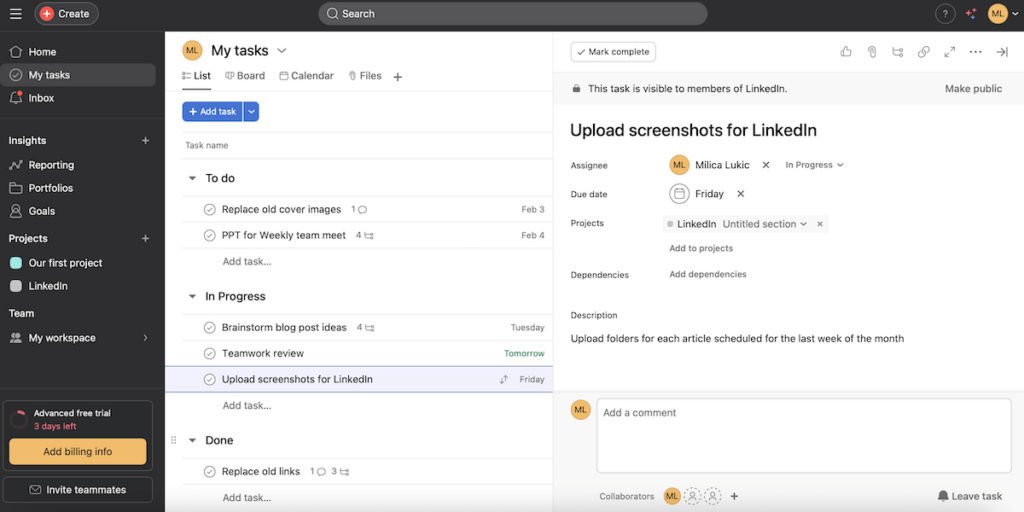
Moreover, the Asana app for Mac is optimized for reliable performance. It supports macOS-friendly shortcuts for quick navigation. Also, you can sync Asana deadlines with Apple Calendar.
As for why I think Asana is a reasonable choice for teams that need workflow automation, there are 2 main reasons:
- You can set up recurring deadlines, which is convenient when dealing with repetitive tasks.
- The so-called Rules feature lets you apply conditions such as automatically assigning or moving tasks when specific actions are performed. You can also edit, pause, or delete a rule, which I found handy.
Lastly, Asana offers numerous integrations with third-party tools, helping you automate cross-app workflows.
Cons of using Asana as a PM tool for Mac
A notable disadvantage when it comes to Asana is the price. It can become costly for larger teams or anyone needing more advanced features. In fact, what I liked the most (e.g., Rules) isn’t available in the free plan at all.
Also, I’m surprised that only 1 user can be the primary assignee within a task. You can rely on comments to tag collaborators or create subtasks for different people, but it’s not as straightforward as allowing multiple assignees for a single task.
What’s new in Asana?
Some recent Asana updates include project smart summaries on Android phones, iOS multi-filter and multi-sort, and curated team pages, as well as private custom fields for Enterprise plan users.
Available for: web, macOS, Windows, Linux, iOS, Android
| Asana’s plans | Asana’s pricing |
|---|---|
| Personal (free) | $0 |
| Starter | $10.99/user/month* |
| Advanced | $24.99/user/month* |
| Enterprise | POA |
| Enterprise+ | POA |
*billed annually

#4 Teamwork — best for client-focused projects
Teamwork is an app designed to facilitate task management and collaboration. Since it incorporates features for billing and client interactions, Teamwork is also suitable for businesses that need to manage external client relationships.
Pros of using Teamwork as a PM tool for Mac
The first thing I noticed about Teamwork is its detailed task management features. Each item can contain:
- Description,
- Assignee,
- Followers,
- Dates,
- Reminders,
- Proofs (for reviewing and approving files), and more.
Like other tools on this list, Teamwork also supports multiple views to visualize project progress depending on your preference.
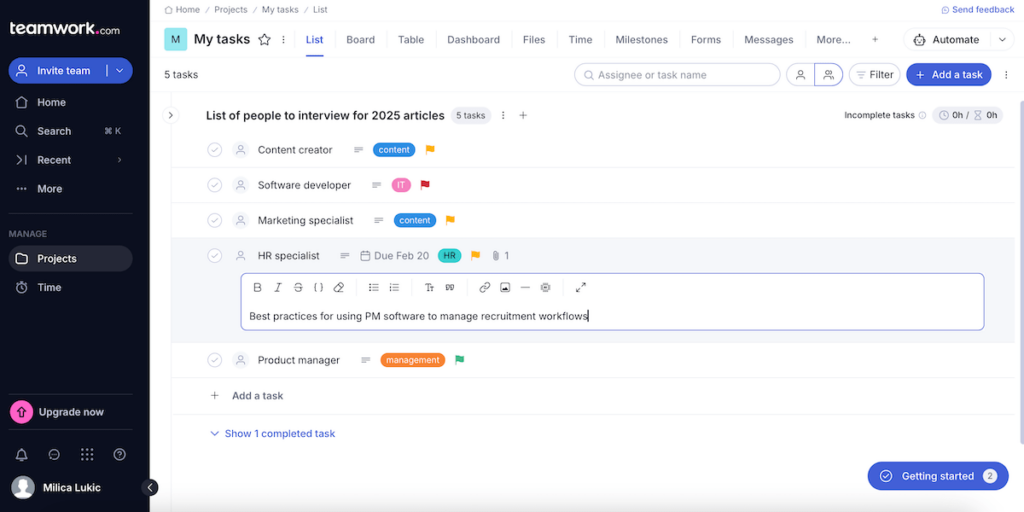
This platform is a solid choice for Mac users because it has a dedicated app, but you can use it as a browser app as well. However, a notable perk of the desktop version is that it supports native macOS notifications to ensure timely alerts.
What I see as Teamwork’s biggest advantage is the ability to handle client-focused projects rather efficiently. This is primarily thanks to these features:
- Clients view — a single place to view and manage all your clients,
- Client permissions — restricted access to specific tasks so that clients can leave feedback without affecting internal operations,
- Time logs — using a timer or logging hours manually to ensure transparency for client reporting, and
- Invoicing — generating invoices directly within the app to simplify the billing process.
Cons of using Teamwork as a PM tool for Mac
Teamwork’s free plan is far too restricting for my taste. First, it can be shared by 5 users maximum. Second, project templates and custom fields are limited as well — you only get to use 2 of each.
And while the paid tiers include useful management and reporting features, they are quite pricey, which can be a problem for budget-conscious teams.
My final complaint is that Teamwork’s mobile app lacks certain advanced features that are available in the desktop version. It isn’t the best for uploading or handling larger files either.
What’s new in Teamwork?
Teamwork now lets you see a summary of the total estimated time between parent tasks and subtasks. Another novelty is Teamwork’s integration with Salesforce.
Available for: web, macOS, Windows, Linux, iOS, Android
| Teamwork’s plans | Teamwork’s pricing |
|---|---|
| Free | $0 (up to 5 users) |
| Deliver | $10.99/user/month* (3 users minimum) |
| Grow | $19.99/user/month* (5 users minimum) |
| Scale | $54.99/user/month* (5 users minimum) |
| Enterprise | POA |
*billed annually
#5 monday.com — best for Agile workflows
monday.com is a software solution that helps teams manage their assignments and project workflows. It caters to various methodologies, but especially to teams looking to implement the Agile approach.
Pros of using monday.com as a PM tool for Mac
The monday.com platform provides several features for effective project management:
- Multiple view options — visualizing work in ways that suit different team members’ preferences,
- Various custom fields — specifying task details like status, due date, task owners, etc.,
- Task automation — building automated workflows to reduce manual effort and errors, and
- Collaboration tools — user tagging and file sharing for centralized communication.
As a Mac owner, you can use this software as a web-based tool, but there’s also a native macOS app offering compatibility with Apple Calendar and system notifications.
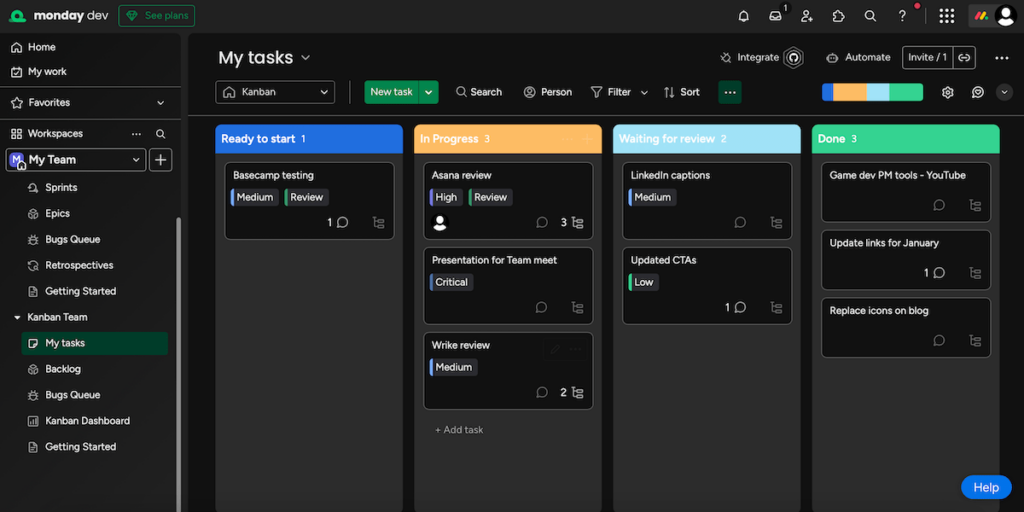
Upon exploring monday.com more, I realized that it can work particularly well for teams implementing Agile project management since it enables:
- Easy backlog management — maintaining a dynamic backlog with drag-and-drop simplicity, and
- Effortless Sprint management — easy creation and management of Sprints using the Kanban or Timeline view.
The platform also lets users set a Work in Progress (WIP) limit (the maximum number of items in a Kanban column) to ensure manageable workloads.
Moreover, you can even define Story Points (SPs) — estimated and actual SPs — to measure the effort and time required to complete a task for better alignment.
Cons of using monday.com as a PM tool for Mac
My biggest issue with monday.com has to do with the design. The extensive customization choices can feel overwhelming. What’s more, the space can become cluttered when working on large projects with too many columns, widgets, and other visual elements.
Another downside is the limited free plan, which allows 2 seats maximum and only 3 boards.
And if you opt for the premium features, you’ll see that the pricing structure is impractical. Seat options come in fixed increments (3, 5, 10, 15, and so on) — so if your team doesn’t align with one of these, you must pay for the next higher tier, resulting in unused seats and higher costs.
What’s new in monday.com?
Several monday.com AI automations are now available — autofill, summarizing, writing assistant, translating text with AI, and more.
Available for: web, macOS, Windows, iOS, Android
| monday.com’s plans | monday.com’s pricing |
|---|---|
| Free | $0 (up to 2 seats) |
| Basic | $9/seat/month* |
| Standard | $12/seat/month* |
| Pro | $19/seat/month* |
| Enterprise | POA |
*billed annually
💡PLAKY PRO TIP
We’ve compared monday.com to several similar platforms. If you’re interested, read these articles:

#6 Smartsheet — best for data-driven project management
Smartsheet is a cloud-based platform that combines the practicality of spreadsheets with robust work management capabilities. It’s designed for organizations employing a data-driven approach to managing complex projects.
Pros of using Smartsheet as a PM tool for Mac
As its name suggests, Smartsheet has a spreadsheet-like interface — customizable rows, columns, and cell formatting allow for detailed project tracking. As someone who’s worked with apps like Excel and Numbers, I found Smartsheet’s layout familiar.
I also appreciated that, besides the classic grid view, there are several other options to cater to diverse PM styles:
- Timeline,
- Board,
- Gantt,
- Card, and
- Calendar.
As for collaboration, it is supported through real-time updates and file sharing.
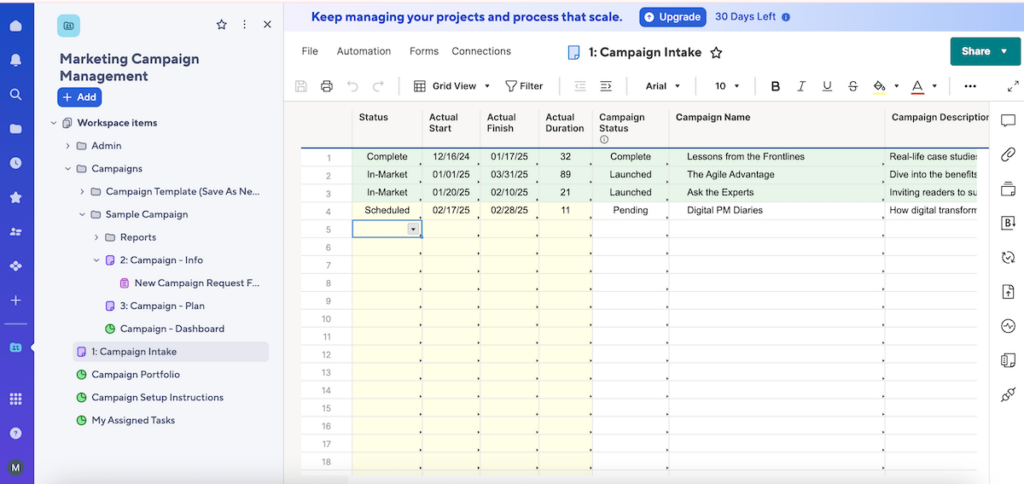
It’s also important to note that Smartsheet has a desktop app for Mac users and is compatible with Apple productivity tools like iCloud, iCal, and Mail for seamless synchronization.
Besides everything mentioned, my experience with Smartsheet showed me this is an excellent tool for data management since it offers:
- Custom reports — several kinds of reports to monitor key metrics, budgeting, etc.,
- Dashboards — dynamic dashboards reflecting the latest data,
- Integration with BI tools — connecting with business intelligence (BI) tools for deeper data analysis, and
- Automation — replacing manual, repetitive tasks with automated workflows to save time.
Cons of using Smartsheet as a PM tool for Mac
Smartsheet has quite a few advanced features, which can be overwhelming for non-technical users. Some teams would likely need detailed training to use this platform at its full capacity.
Plus, while most users are typically familiar with the spreadsheet interface, the overdependence on such a visual approach makes this platform somewhat less modern-looking than other tools on this list.
Finally, let’s not forget that Smartsheet actually discontinued its free plan recently, so you don’t have a choice but to get one of the paid plans if you want to use this platform.
What’s new in Smartsheet?
The Smartsheet Control Center now provides real-time updates for project provisioning, allowing Business and Enterprise plan users to track progress directly from the project list.
Available for: web, macOS, Windows, iOS, Android
| Smartsheet’s plans | Smartsheet’s pricing |
|---|---|
| Free | ❌ |
| Pro | $9/member/month* (1-10 members) |
| Business | $19/member/month* (3+members) |
| Enterprise | POA (10+ members) |
| Advanced Work Management | POA |
*billed annually
#7 Wrike — best for resource management
Wrike is a project management app used to monitor work and collaborative tasks. Thanks to several tracking and forecasting tools, Wrike is known for its solid resource management capabilities too.
Pros of using Wrike as a PM tool for Mac
Wrike is equipped with features for rich task management. This tool enables task creation, prioritization, and assignment to users, with multiple views to present projects visually:
- Table,
- Board,
- Gantt chart,
- Calendar,
- Chart view,
- Resources, and more.
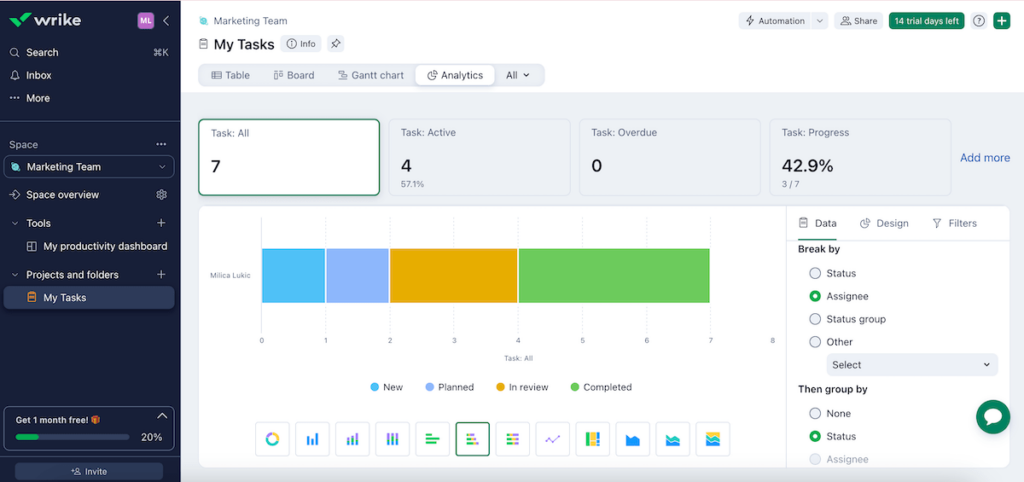
The design is functional, running smoothly both on the web and the desktop version. Wrike supports macOS-specific features like notifications and shortcuts for an optimized user experience. Plus, you can connect Wrike with macOS tools like iCloud and Apple Mail.
That said, my experience with this app led me to conclude that it’s best suited for teams that need robust resource management features like:
- Workload charts — to help you identify overworked or underutilized team members,
- Capacity planning — to forecast team availability with predictive tools and adjust plans accordingly,
- Budgeting — to compare planned vs actual costs (and prevent cost variance), and
- Built-in timer — to track real time spent on tasks or make manual entries to facilitate the future planning of project resources.
Cons of using Wrike as a PM tool for Mac
Once my free trial with all the features expired, I was disappointed to find out that I could no longer use Wrike’s custom fields — only the basic fields that come with each task.
In addition, all the useful resource planning features are only available on the Business plan and up, making Wrike less accessible to cost-conscious users.
And if you decide to go with a higher-tier plan, there’s definitely a learning curve regarding all the customization options and analytics.
What’s new in Wrike?
Wrike recently had some dashboard updates: project task structure in the table format, text and link widgets, and data label customization. There are also some new themes and a dark mode update.
Available for: web, macOS, Windows, iOS, Android
| Wrike’s plans | Wrike’s pricing |
|---|---|
| Free | $0 |
| Team | $10/user/month |
| Business | $24.80/user/month |
| Enterprise | POA |
| Pinnacle | POA |
💡PLAKY PRO TIP
Want to see how Wrike stacks up against 2 other tools on our list? Check these out:
#8 Basecamp — best for simplified team communication
Basecamp is a platform for managing work and staying organized that boasts a user-friendly design and different messaging options. Overall, this tool is a sensible choice for teams that prioritize streamlined communication and collaboration.
Pros of using Basecamp as a PM tool for Mac
Basecamp has several features tailored to enhance project management. Each project has a page with the following segments:
- Message board — for making announcements and discussing ideas,
- To-dos — for tracking assignments,
- Chat — for easy and quick communication,
- Docs & Files — for storing project-related documents and media, and
- Schedule — for monitoring milestones and deadlines.
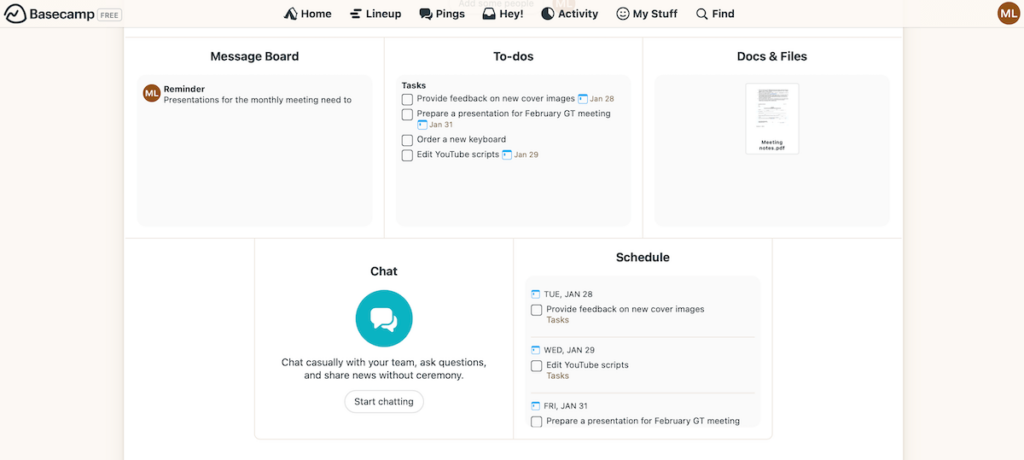
What sets Basecamp apart is its focus on team communication. The following functionalities make it easier to stay aligned:
- Real-time chat — a way to reduce reliance on scattered conversations and emails,
- Pings — private messages to allow direct, private communication,
- Project activity — a chronological list of all actions made within a project, and
- Customizable notifications — staying informed without unnecessary alerts.
Overall, the user experience on Basecamp is smooth for Mac users — there is a dedicated desktop app that allows you to sync with macOS calendar apps.
Another strong point I noticed is that changes made on your desktop sync automatically with the mobile version, guaranteeing continuity across devices.
Cons of using Basecamp as a PM tool for Mac
While Basecamp’s simplicity has benefits, there’s a notable lack of advanced customization options for workflow and dashboards. So, there will likely be some scalability challenges for larger teams managing complex projects.
Plus, Basecamp doesn’t offer Gantt charts or Kanban boards, which may limit your project planning options.
Finally, I encountered some issues with saving changes to my to-do list in Basecamp’s browser version, making me refresh the page a few times. I also had a problem with a file upload despite sticking to the storage limit.
What’s new in Basecamp?
In addition to several bug fixes and improvements, Basecamp has introduced the possibility to share entire folders with people outside your account (previously, users could only share individual documents).
Available for: web, macOS, Windows, iOS, Android
| Basecamp’s plans | Basecamp’s pricing |
|---|---|
| Free | $0 |
| Plus | $15/user/month |
| Pro Unlimited | $299/month billed annually |
💡PLAKY PRO TIP
Need a Basecamp alternative? Check out our overview below:
#9 Todoist — best for minimalists
Todoist is a task management app that helps teams and individuals create neat to-do lists and track progress. With its elegant design, this tool is a solid option for users who enjoy the minimalist look.
Pros of using Todoist as a PM tool for Mac
Todoist is a simple yet rather effective solution for handling your tasks. This app lets you:
- Segment work hierarchically into tasks and subtasks,
- Use custom labels and filters to categorize and find assignments quickly,
- Assign priority levels to ensure focus on important matters, and
- Set reminders to avoid overlooking important tasks.
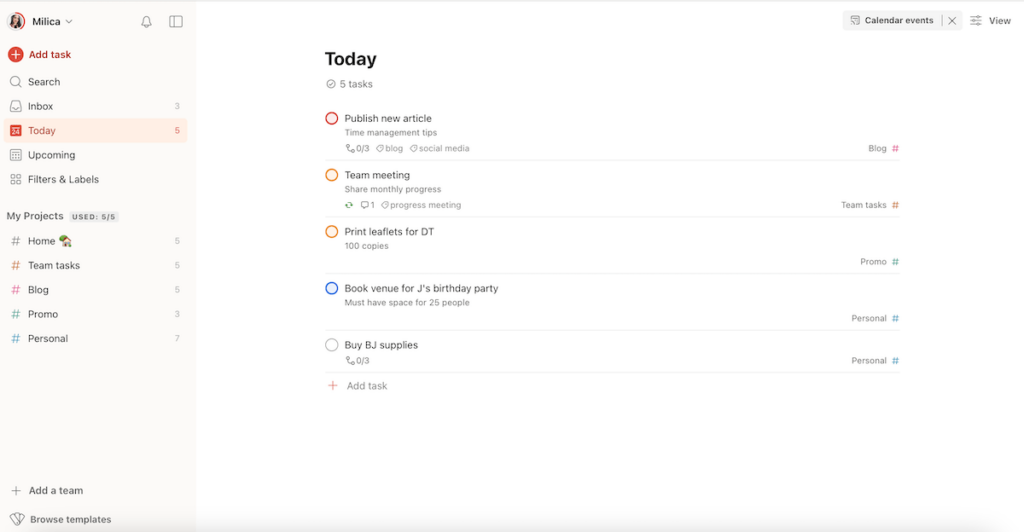
As for team collaboration in Todoist, it mainly involves assigning items to different users, as well as utilizing comments and attachments.
Mac users will be glad to hear that Todoist’s macOS app ensures seamless integration with Apple devices and calendars. Additionally, the application integrates with Siri, letting you create comments and tasks using voice commands.
Another feature that makes Todoist special is the so-called Karma segment — a gamified system that tracks productivity via points to keep you motivated and consistent.
All of this comes with a minimalist design, which is achieved through:
- Clutter-free layout in all view types,
- Customizable navigation bar,
- Soft color palette, and
- Natural language input.
Cons of using Todoist as a PM tool for Mac
My biggest complaint during the time I used Todoist has to do with delays in app syncing. This can be irritating for collaborative projects relying heavily on real-time updates.
I was also surprised to see that adding deadlines within a task card is reserved for premium users. Apparently, it’s because the deadline field marks an obligation, whereas the regular date field refers to when you plan to do a task.
What’s new in Todoist?
The previously mentioned deadline field is a recently added feature in Todoist. There have also been some minor but helpful improvements to the Google Calendar integration, task grouping, automatic sorting, and more.
Available for: web, macOS, Windows, Linux, iOS, Apple Watch, Android, Wear OS
| Todoist’s plans | Todoist’s pricing |
|---|---|
| Beginner (free) | $0 |
| Pro | $4/user/month* |
| Business | $6/user/month* |
*billed annually
#10 Miro — best for brainstorming sessions
Miro is a collaborative whiteboard platform primarily designed for idea visualization and project planning. As a highly interactive workspace, it’s convenient for teams that like brainstorming and sharing ideas in real time.
Pros of using Miro as a PM tool for Mac
There are several features for effective project management in Miro:
- Kanban boards and timelines — for tracking tasks and project timelines,
- Integrations with other PM tools — enabling a more streamlined project workflow,
- Real-time collaboration — allowing multiple users to work on the same board at the same time, and
- 2,500+ diagram types — presenting different data without switching apps.

That said, this platform’s strongest point lies in its brainstorming and visualization tools. These are my favorite Miro features to facilitate creative and planning processes:
- Infinite canvas — an endless digital space to store all ideas,
- Engagement tools — sticky notes, voting systems, mind maps, and others,
- Multimedia integration — uploading images, videos, etc. to enrich discussions,
- Templates library — pre-designed templates simplifying user experience, and
- Video chat — video calls for brainstorming sessions where face-to-face communication is desirable.
Finally, I’ll mention that Miro is fully optimized for Mac users since there is a native app integrating seamlessly with macOS features. Miro’s design also takes full advantage of macOS Retina displays to ensure crisp visuals.
Cons of using Miro as a PM tool for Mac
The abundance of features can be overwhelming for first-time Miro users, so if that applies to you, be prepared to take some time to explore and learn.
More importantly, this app can be quite demanding on system resources, especially on older Mac devices. This could lead to slower performance if you have large boards with many elements.
Lastly, certain features are desktop-exclusive (e.g., some diagrams or apps & plugins). So, if you’re a project manager or designer who likes working on the go but needs Miro’s advanced functionalities, you’ll likely need to rely on your computer or tablet more.
What’s new in Miro?
Miro has some new widgets: alignment scales (measuring agreement on specific topics), spinner wheels (randomly selecting an option from a list), T-shirt sizes (visually estimating effort or complexity), and sticky stacks (grouping related sticky notes).
Available for: web, macOS, Windows, iOS, Android
| Miro’s plans | Miro’s pricing |
|---|---|
| Free | $0 |
| Starter | $8/member/month* |
| Business | $16/member/month* |
| Enterprise | POA |
*billed annually
How to pick the right PM software for Mac
Choosing a project management tool as a Mac user goes beyond just finding one that runs on macOS. You need a reliable solution that offers the right balance of features, usability, and cost.
So, here are some factors to keep in mind:
- Ease of use — Your PM tool should be intuitive and user-friendly to avoid a steep learning curve.
- Performance and system resource usage — The software should run efficiently on Mac hardware without slowing down performance or draining battery life fast.
- Design — The design should align with macOS aesthetics and offer a clean experience.
- Scalability — The tool should be able to grow with your team and projects, enabling workflow customization as the work evolves.
- Customer support — Having 24/7 customer support with a quick response time would be ideal, along with some help docs and tutorials.
- Budget — Look for a pricing structure that fits your budget, and if you need to be cost-conscious, ensure that key features aren’t locked behind paid plans.
💡PLAKY PRO TIP
For a more in-depth guide on selecting a PM tool wisely, read this article:
Ensure project success with the best PM tool for your Mac
Choosing an adequate project management platform as a Mac user depends on your needs, workflow, and project constraints. Whatever you prioritize, the right software can make all the difference in keeping your tasks on track.
For most users, the powerful yet affordable combo is the goal, which is why our platform, Plaky, stands out.
With its generous free plan, flexible project structure, and intuitive interface, Plaky is a great fit for teams of all sizes seeking a powerful PM solution. And in the unlikely event that something goes wrong, our support team is ready to answer all your questions at all times.
Bonus? Our Pro and Enterprise users can also qualify for a tailored onboarding program and a dedicated success representative.
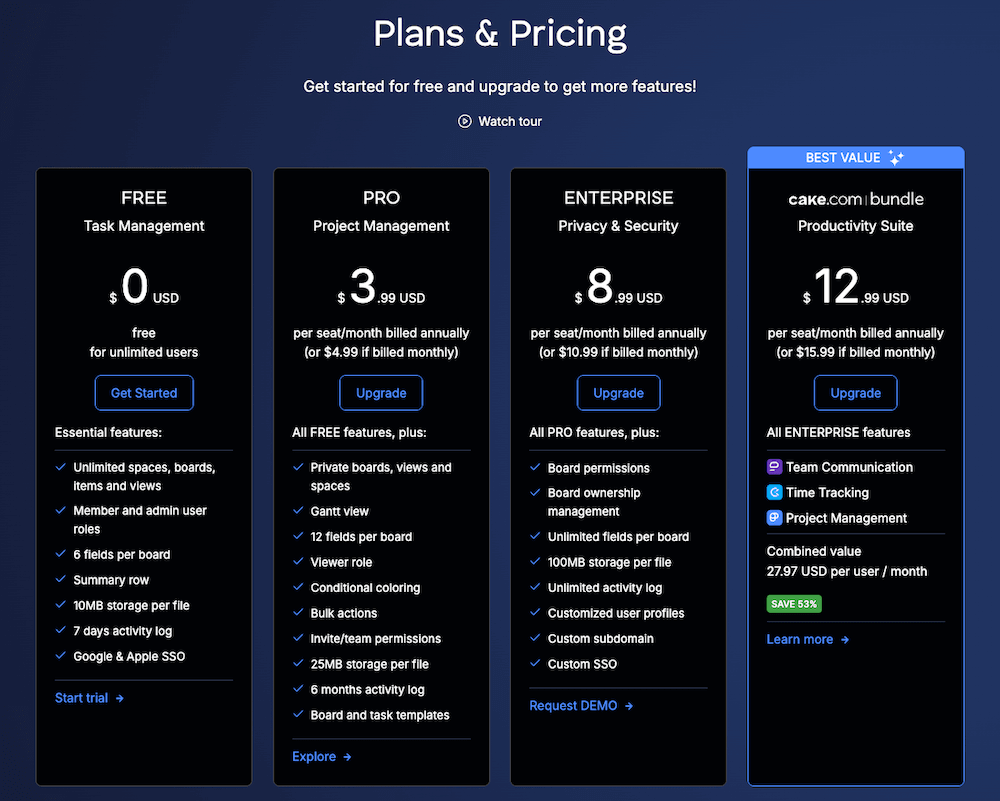
Want a reliable PM tool for Mac? Get a free Plaky account today and ensure seamless project management!
